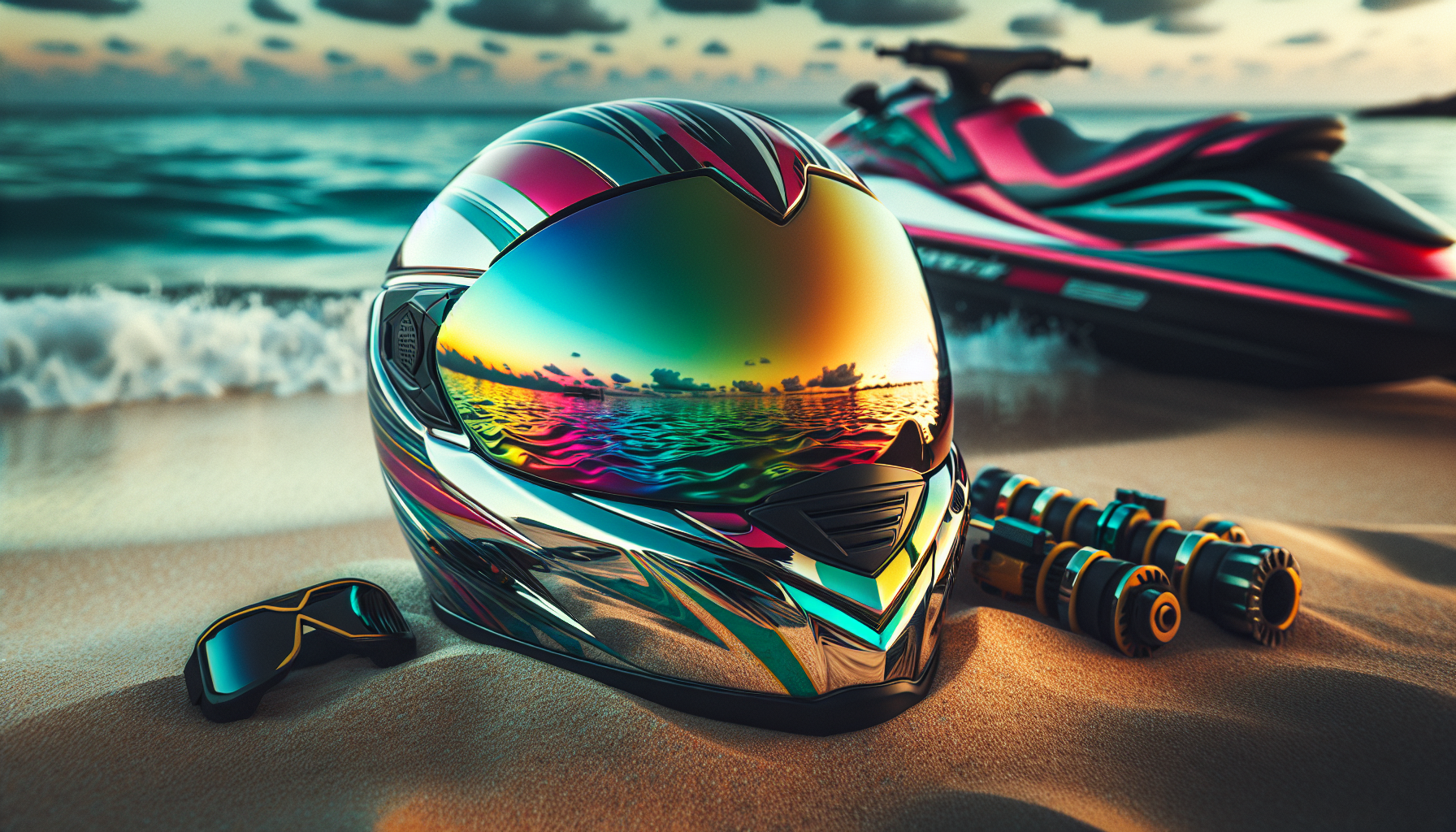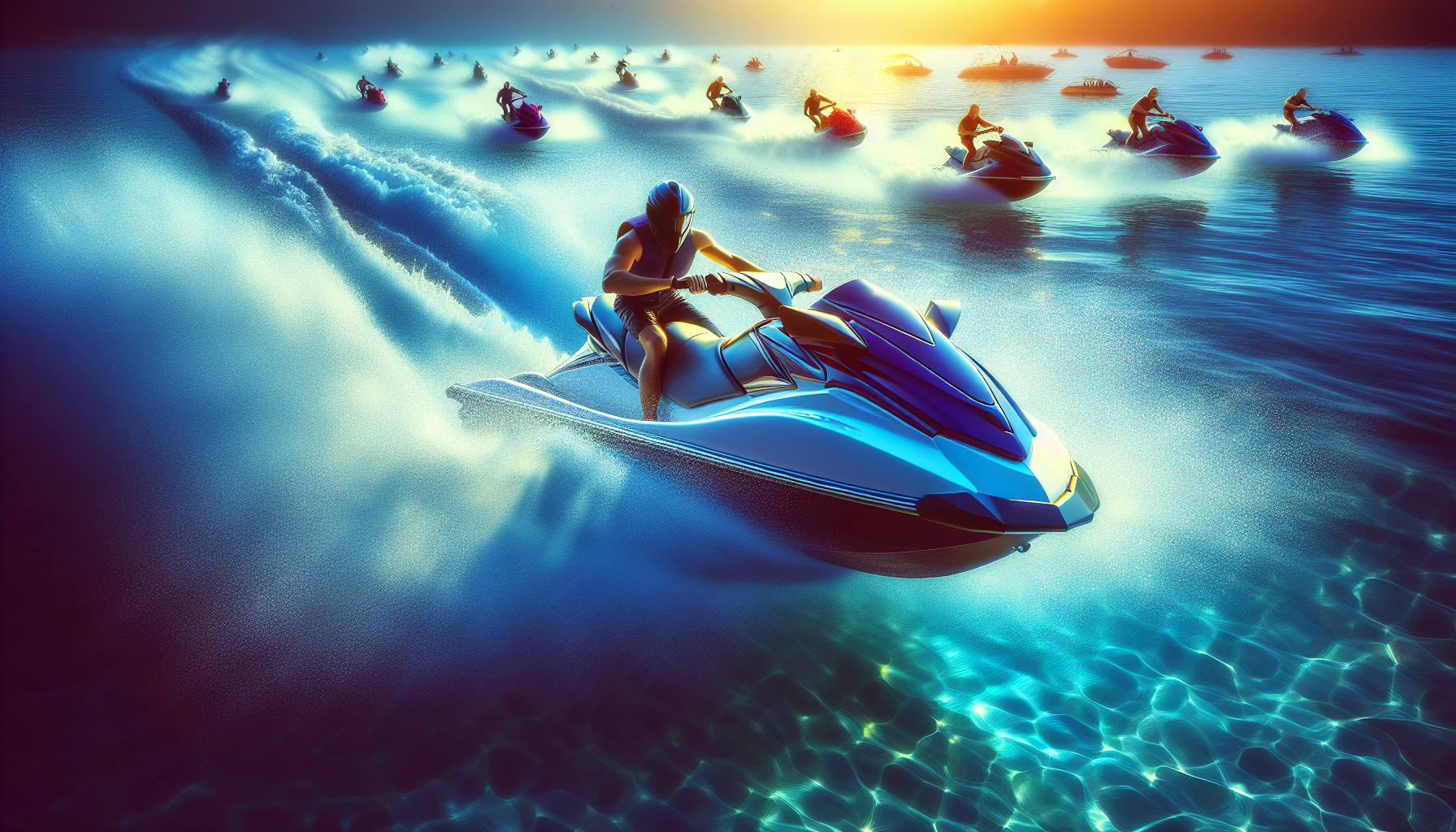Recommended gear and apparel for Jet Skiers

Jet skiing is an exhilarating water sport that promises endless fun and adventure. But before you hit the open water, it’s crucial to ensure that you’re equipped with the right gear and apparel to maximize your safety and enjoyment. From protective wetsuits to sturdy life vests, having the appropriate equipment can make all the difference. When it comes to jet skiing, A2Z Powersport is your go-to destination for renting top-of-the-line jet skis and getting expert advice. Located at the Fort Morgan Marina in Orange Beach, Alabama, they are the watersport experts who can provide you with everything you need for an unforgettable jet skiing experience. So, gear up and get ready to make a splash with A2Z Powersport!
Helmet
When it comes to jet skiing, safety should always be a top priority. One of the most important pieces of protective gear you should have is a helmet. Wearing a helmet while jet skiing can greatly reduce the risk of head injuries in case of accidents or falls.
Why wear a helmet
Wearing a helmet while jet skiing is crucial for your safety. It helps protect your head from potential impacts with the water, other objects, or even the jet ski itself. A helmet acts as a barrier between your head and any external forces, reducing the risk of severe injuries such as concussions or skull fractures.
Types of helmets for jet skiers
There are several types of helmets available for jet skiers, each designed to cater to specific needs and preferences. Full-face helmets provide the most comprehensive protection, covering your entire head and face. Open-face helmets offer protection to the top of your head while leaving your face exposed. Modular helmets combine the benefits of full-face and open-face helmets, allowing you to lift the front chin bar when needed.
Features to consider in a jet ski helmet
When choosing a helmet for jet skiing, there are certain features you should consider. Look for helmets with a secure and comfortable fit, adjustable straps, and padding for added comfort. Ventilation is essential to prevent overheating, especially on hot days. Additionally, opt for helmets with a durable outer shell and a visor or shield to protect your face from wind, water, and debris.
Life Jacket
Next on the list of essential gear for jet skiing is a life jacket. Wearing a properly fitting life jacket is crucial for your safety on the water, as it can potentially save your life in case of emergencies or unexpected situations.
Importance of wearing a life jacket
Wearing a life jacket while jet skiing is not just a recommendation; it’s a legal requirement in many areas. Life jackets provide buoyancy, keeping you afloat in case you fall into the water or become unconscious. They are designed to keep your head above water, allowing you to breathe freely and increasing your chances of rescue.
Choosing the right size and fit
When selecting a life jacket, it’s important to choose one that fits you properly. Ensure that the life jacket is snug but not too tight, allowing for comfortable movement and unrestricted breathing. Check the manufacturer’s size and weight guidelines to ensure the right fit. Adjustable straps and buckles can help customize the fit to your body shape.
Different types of life jackets
There are various types of life jackets available, each suitable for different water activities. Type III life jackets are the most common for recreational water sports, including jet skiing. They offer a good balance between mobility and buoyancy. Inflatable life jackets are another popular option, providing a compact and lightweight alternative. However, make sure to check the regulations in your area to ensure the type of life jacket you choose is approved for jet skiing.
Wetsuit
Jet skiing often involves being in contact with cold water, which can quickly lead to discomfort and even hypothermia. Wearing a wetsuit can provide insulation and protection against the cold, allowing you to enjoy your time on the water comfortably.
Protection against cold water
A wetsuit is designed to trap a thin layer of water between your body and the suit itself. This layer then warms up to match your body temperature, providing insulation against the colder external water. This insulation helps regulate your body heat and prevents hypothermia, especially in colder climates or during extended periods in the water.
Types of wetsuits for jet skiing
There are different types of wetsuits available, depending on the water temperature and your personal preferences. Full wetsuits cover your entire body and are suitable for colder waters. Shorty wetsuits, with shorter sleeves and legs, offer more mobility and are better suited for warmer conditions. Choose a wetsuit thickness that corresponds to the water temperature you will be jet skiing in, as thicker suits provide more insulation.
Factors to consider when buying a wetsuit
When purchasing a wetsuit for jet skiing, consider factors such as material, flexibility, and durability. Neoprene is the most common material used for wetsuits due to its insulating properties. Look for wetsuits with good stretch and range of motion, as this will allow for better movement while on the jet ski. Ensure the suit is well-fitted and comfortable, with sealed seams to prevent water seepage.
Goggles
While jet skiing, your eyes can be exposed to water splashes, wind, and debris, which can be uncomfortable and potentially hazardous. Wearing goggles helps protect your eyes, ensuring clear vision and preventing any damage caused by flying particles.
Protecting your eyes from water and debris
Jet skiing involves high speeds and water splashes, which can irritate your eyes and affect your vision. Goggles create a protective barrier, shielding your eyes from water and reducing the chance of water entering and causing discomfort. Goggles also prevent debris, such as sand or small rocks, from hitting your eyes, preventing potential injuries and ensuring clear vision throughout your ride.
Different lens options for jet ski goggles
Goggles come with various lens options, each offering different benefits depending on the conditions you’ll be jet skiing in. Clear lenses provide optimal visibility in normal daylight conditions, allowing you to see clearly without distortion. Mirrored or polarized lenses are ideal for bright and sunny conditions, reducing glare from the water’s surface and enhancing visibility. Yellow or amber lenses can enhance contrast in low-light conditions, making them ideal for early morning or late evening rides.
Anti-fog and UV protection features
Look for goggles with anti-fog coatings or ventilation systems to prevent fogging caused by the temperature difference between your face and the water. Anti-fog features ensure a clear view throughout your ride, allowing you to navigate without any hindrances. Additionally, opt for goggles that offer UV protection to shield your eyes from harmful rays, especially when riding in bright and sunny conditions.
Neoprene Gloves
When jet skiing in colder climates or during colder seasons, wearing neoprene gloves is essential. These gloves provide insulation, grip, and protection for your hands, ensuring comfort and control while maneuvering the jet ski.
Insulation and grip
Neoprene gloves are designed to keep your hands warm in colder water temperatures. The neoprene material traps a layer of water against your skin, allowing your body heat to warm it and provide insulation. This insulation prevents your hands from getting numb or cold, enabling better control and responsiveness while operating the jet ski. Additionally, neoprene gloves often feature textured palms or grip-enhancing materials, ensuring a secure hold on the handlebars even when wet.
Benefits of wearing neoprene gloves
Wearing neoprene gloves offers several benefits beyond insulation. They provide added protection for your hands against potential impacts with the water or other objects. The gloves also act as a barrier, reducing the risk of developing blisters or calluses while gripping the jet ski handles. Neoprene gloves are lightweight and flexible, allowing for a comfortable fit and unrestricted hand movement.
Choosing the right size and thickness
When selecting neoprene gloves for jet skiing, make sure to choose the right size for a snug fit. Gloves that are too loose can affect your grip and dexterity, while gloves that are too tight may restrict hand movement. Consider the thickness of the gloves based on the water temperature you’ll be jet skiing in. Thicker gloves provide better insulation in colder waters, while thinner gloves offer greater flexibility and dexterity in milder conditions.
Footwear
proper footwear is often overlooked but plays a crucial role in ensuring a safe and comfortable jet skiing experience. Wearing suitable shoes can provide grip, protection, and stability while walking on slippery surfaces or using the jet ski controls.
Importance of proper footwear
While on a jet ski, you may encounter wet and slippery surfaces, both on the watercraft and around the launch area. Wearing proper footwear helps prevent slips, falls, and potential injuries. Shoes designed specifically for water sports provide better traction and grip, allowing for secure footing even on wet or uneven surfaces. Additionally, proper footwear protects your feet from sharp objects, hot surfaces, or accidental contact with the jet ski’s moving parts.
Types of shoes suitable for jet skiing
Water shoes, aqua socks, or deck shoes are all suitable options for jet skiing. These shoes are designed to be worn in and around water, offering quick-drying materials and non-slip soles. They are often lightweight and flexible, providing comfort and mobility while maneuvering the jet ski. Look for shoes that have a snug fit without being too tight, ensuring they stay securely on your feet during the ride.
Non-slip and water-resistant features
When selecting footwear for jet skiing, prioritize shoes with non-slip soles to provide excellent traction on wet surfaces. This ensures stability while getting on or off the jet ski, as well as when walking on wet docks or other slippery areas. Water-resistant or quick-drying materials are also essential to prevent the shoes from becoming waterlogged or uncomfortably heavy. Shoes with breathable features help to keep your feet cool and dry, reducing the risk of discomfort or foot-related issues.
Rash Guard
Exposure to the sun’s harmful UV rays is a concern while jet skiing, as you are often exposed to extended periods of direct sunlight. Wearing a rash guard provides protection against sunburn and abrasions, keeping your skin safe and comfortable.
Protection against sunburn and abrasions
A rash guard is a lightweight and quick-drying garment designed to protect your skin from the sun and other potential irritants. It acts as a barrier against harmful UV rays, reducing the risk of sunburn and long-term damage caused by prolonged sun exposure. Additionally, a rash guard provides protection against abrasions and irritations that may occur from contact with the jet ski or other surfaces while riding.
Materials and UPF ratings for rash guards
Rash guards are typically made from synthetic materials such as nylon, spandex, or polyester. These materials are lightweight, breathable, and quick-drying, allowing for maximum comfort during your jet skiing adventures. When choosing a rash guard, look for the UPF (Ultraviolet Protection Factor) rating, which indicates the level of UV protection provided by the fabric. Opt for a rash guard with a higher UPF rating, such as UPF 50+, for optimal sun protection.
Choosing the right fit and style
Rash guards come in various styles, including short-sleeved, long-sleeved, and even full-body coverage options. Choose a fit that allows for easy movement and doesn’t restrict your range of motion. A snug yet comfortable fit ensures that the rash guard stays in place and provides adequate protection. Consider your personal preference, such as color or design, to choose a rash guard that suits your style and enhances your overall jet skiing experience.
Dry Bag
While out on the water, it’s essential to keep your belongings safe and dry. A dry bag is a waterproof storage solution that can protect your valuables, electronics, and other essentials from water damage.
Keeping your belongings safe and dry
A dry bag is a must-have accessory for jet skiers to store items such as phones, cameras, extra clothing, and snacks. The waterproof construction of a dry bag ensures that water does not seep in, protecting your belongings from potential damage. Whether you encounter splashes, accidental submersion, or adverse weather conditions, a dry bag offers peace of mind by keeping your valuables safe and dry.
Sizes and closure mechanisms
Dry bags come in various sizes, allowing you to choose one that suits your storage needs. Smaller dry bags are suitable for essentials like keys, wallets, or phones, while larger ones can accommodate bulkier items or multiple belongings. The closure mechanism is another crucial aspect to consider when selecting a dry bag. Roll-top closures are the most common, allowing you to roll down the opening and secure it with buckles or clips, ensuring a watertight seal.
Features to consider in a jet ski dry bag
When choosing a dry bag for jet skiing, look for additional features that enhance its functionality. Some dry bags come with handles or straps for easy carrying or attachment to the jet ski. External pockets can provide quick access to items you may need more frequently. Durable materials, such as PVC or nylon, ensure the bag can withstand rough handling and protect your belongings for years to come. Consider the color or visibility of the bag to ensure easy spotting in case it goes overboard.
Tow Ropes
Tow ropes are essential for jet skiers who enjoy water sports such as tubing, wakeboarding, or water skiing. These ropes provide the connection between the jet ski and the person being towed, ensuring safety and allowing for an exciting and thrilling experience.
Purpose and importance of tow ropes
Tow ropes play a vital role in water sports activities, acting as the connection between the jet ski and the towable device or person being towed. The quality and strength of the tow rope are crucial for safe towing, ensuring that it can withstand the forces exerted during high-speed maneuvers. Properly securing the tow rope to the jet ski and the towable device or person is essential to prevent accidents or injuries.
Types of ropes for jet skiing
There are different types of tow ropes available for jet skiing, each designed for specific water sports activities. Water skiing ropes are typically longer and have a wider handle, allowing for easy gripping and maneuvering. Wakeboard ropes are shorter and thicker, providing better control and stability during aerial tricks and jumps. Tubes and inflatables often require tow ropes with extra strength and buoyancy, ensuring a safe and enjoyable experience for both riders and the jet ski operator.
Length and strength considerations
When selecting a tow rope, consider the length and strength requirements based on the specific water sport and the number of riders. Longer tow ropes allow for a wider range of movements and greater flexibility, while shorter ones provide better control and responsiveness. The strength of the tow rope should be sufficient to handle the weight and forces exerted during towing, ensuring durability and safety. Always follow the manufacturer’s recommendations and guidelines when choosing a tow rope to ensure a safe and enjoyable experience.
Emergency Whistle
In emergency situations, having a means of signaling for help can be critical. An emergency whistle is a compact and easy-to-use tool that can attract attention and provide a distress signal in case of emergencies while jet skiing.
Signaling for help in emergency situations
An emergency whistle can be a lifesaver in situations where verbal communication may not be possible or effective. In case of an accident, injury, or distress, blowing an emergency whistle creates a distinct and loud sound that can attract attention from other boaters, nearby people, or emergency responders. The sound carries over long distances and can help rescuers locate you more quickly, potentially reducing response times and increasing the chances of a successful rescue.
Loudness and durability of whistles
When choosing an emergency whistle, consider its loudness and durability. Whistles with higher decibel ratings produce louder sounds, ensuring they can be heard over significant distances or in noisy environments. Look for whistles made from durable materials such as plastic, metal, or stainless steel, ensuring they can withstand exposure to water, rough handling, and the elements. Opt for whistles that are designed to be buoyant, so they stay afloat in case they accidentally go overboard.
Attachment options for easy access
Having easy access to your emergency whistle is crucial during an emergency situation. Look for whistles that come with attachment options, such as lanyards or clips, allowing you to secure them to your life jacket, backpack, or other gear. This ensures that the whistle is readily available when needed and prevents it from getting lost or misplaced. Practice using the whistle before heading out on your jet ski to familiarize yourself with its operation and ensure it functions properly.
In conclusion, when it comes to jet skiing, having the right gear and apparel is essential for both your comfort and safety. Wearing a helmet, life jacket, and appropriate clothing like a wetsuit, rash guard, and neoprene gloves provides protection against potential injuries and keeps you comfortable while on the water. Goggles protect your eyes from water and debris, while proper footwear ensures stability and prevents slips and falls. Keeping your belongings safe and dry is made possible with the use of a dry bag, and tow ropes allow for an exhilarating experience in various water sports. Lastly, an emergency whistle is a crucial tool that can attract help in case of emergencies. Remember to choose gear and apparel that suit your needs, prioritize safety, and enhance your overall jet skiing experience. For jet ski rentals and further assistance, consider reaching out to the watersport experts at A2Z Powersport, located at the Fort Morgan Marina in Orange Beach, AL.










